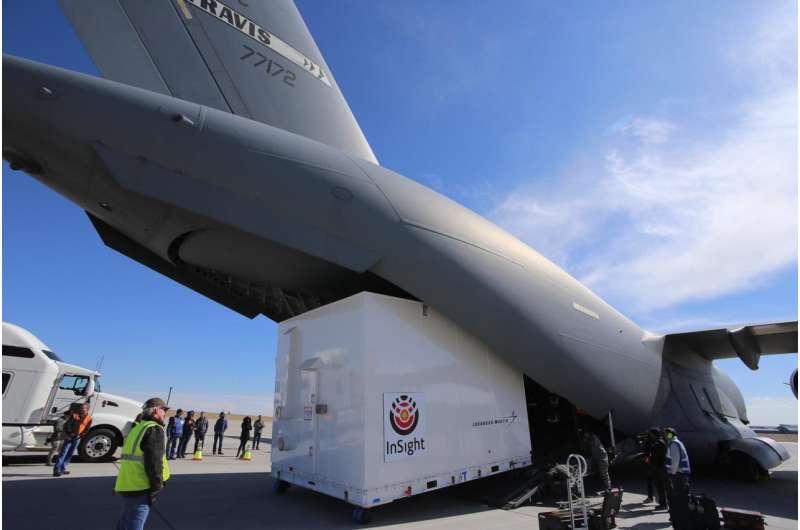NASA InSight mission to Mars arrives at launch site

NASA's InSight spacecraft has arrived at Vandenberg Air Force Base in central California to begin final preparations for a launch this May. The spacecraft was shipped from Lockheed Martin Space, Denver, today and arrived at Vandenberg at 3:49 p.m. PST (6:49 p.m. EST). The launch period for InSight opens May 5 and continues through June 8. InSight will be the first mission to look deep beneath the Martian surface, studying the planet's interior by listening for marsquakes and measuring the planet's heat output. It will also be the first planetary spacecraft to launch from the West Coast.
"The Air Force C-17 crew from the 21st Airlift Squadron gave us a great ride," said Tom Hoffman, InSight project manager, from NASA's Jet Propulsion Laboratory in Pasadena, California. "Next time InSight travels as high and as fast, it will be about 23 seconds into its launch, on the way to Mars."
At the Astrotech payload processing facility at Vandenberg, InSight will soon be removed from its shipping container—the first of several remaining milestones to prepare it for launch. Later next week, the spacecraft will begin functional testing to verify its state of health after the flight from Colorado. After that, the team will load updated flight software and perform a series of mission readiness tests. These tests involve the entire spacecraft flight system, the associated science instruments and the ground data system.
"One of the most important activities before launch is to load the spacecraft with the fuel needed for the journey to Mars," said Hoffman. "After fuel loading, the spacecraft will undergo a spin-balance test to determine precisely the center of mass. This knowledge is needed to be sure the entry and descent into the Mars atmosphere goes as planned."
InSight will be carried into space aboard a United Launch Alliance Atlas V-401 rocket lifting off from Space Launch Complex 3E at Vandenberg Air Force Base. For a May 5 liftoff, the launch window opens at 4:05 a.m. PDT (7:05 a.m. EDT) and remains open through 6:05 a.m. PDT (9:05 a.m. EDT).
InSight will use the seismic waves generated by marsquakes to map the deep interior of Mars. These waves travel through geologic materials at different speeds and reflect off boundaries, giving scientists a glimpse of the composition and structure of the planet's interior. They reflect the initial formation of the planet, and the resulting insights into how Mars formed will help us better understand how other rocky planets are created, including our own Earth.
Provided by NASA





















